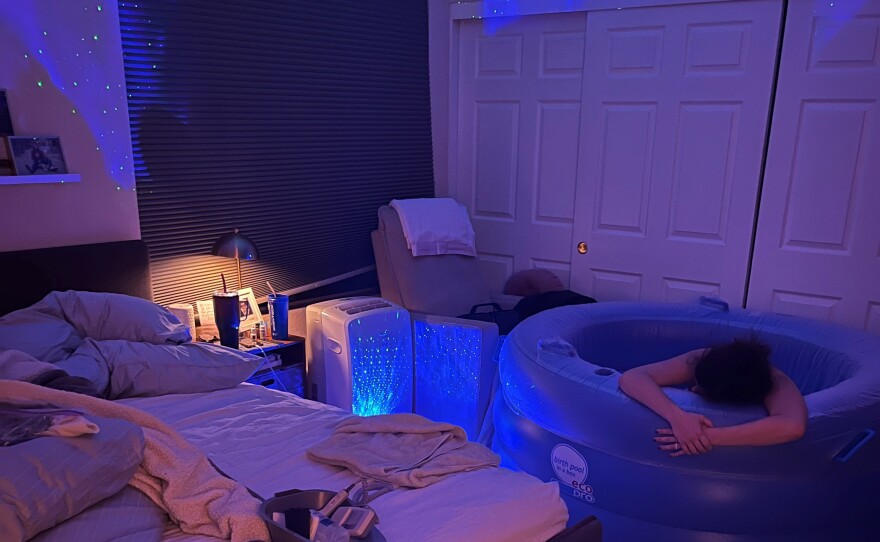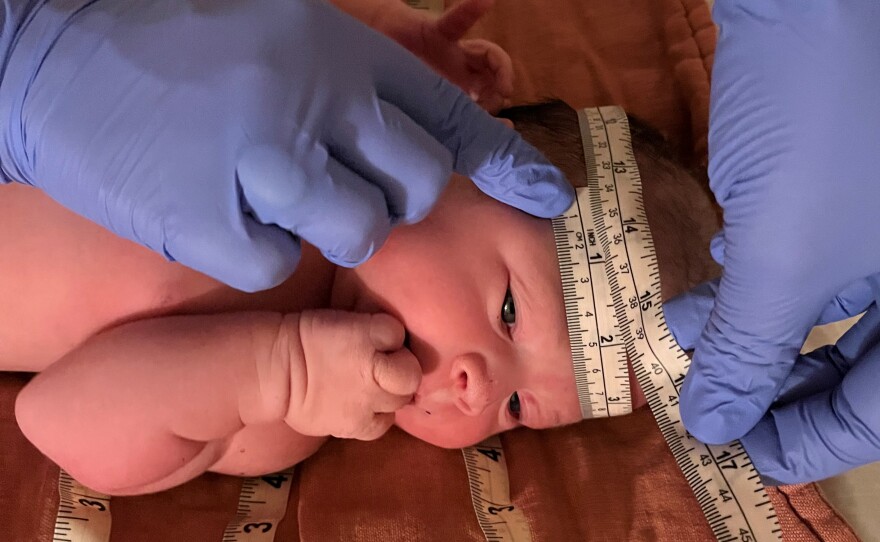In March 2022, Emily was pregnant with her first baby and excited to become a mother. But she was a lot less excited about the idea of giving birth in a hospital, especially in the age of COVID-19.
“It was uncertain whether there would be restrictions on the number of people in the room, and you probably have to wear a mask,” she said.
Emily — who asked to be identified by only her first name for privacy — said those restrictions led her to think about alternatives. She already knew she wanted to have autonomy over her birth experience and to avoid other medical interventions that can come with a hospital birth.
Then she had an unsettling prenatal appointment. When Emily told her doctor she wanted to give birth without an epidural, the doctor laughed and said she hears that from a lot of expectant mothers who end up changing their minds.
That's when Emily made the final decision to give birth at home.
“I know a lot of people work from home and have just found creative ways to do things that they would normally do in a different setting in the home setting,” Emily said. “I think that has inspired a lot of people to think about, ‘hey, is it possible for me to give birth at home?’”
Since the onset of the pandemic in early 2020, the number of home births has climbed dramatically, both nationally and in San Diego County. Countywide, the number of home births rose by 28% from the year before COVID-19 to the end of 2022.
To be sure, the 576 at-home births in 2022 was just a small fraction of the more than 37,000 births countywide last year. But the increase is significant — Emily said it was difficult to find an available midwife.
Some women have births outside the hospital by accident — their babies come too quickly and they don’t make it to the hospital on time. Most, however, plan their at-home birth and hire a certified midwife who will arrive at their home during labor and guide them through the birth process. They have medical tools on hand to assist if needed.
“She had oxygen tanks, she had all the things she needed to suture if there was any tearing, she had medication in place if there was hemorrhaging, any of the main complications that would happen,” Emily said of her midwife.
She added that the midwife was trained in responding to more than just minor complications, including if the umbilical cord is wrapped around the baby's neck, or if the baby needs help breathing.
A 2014 California law allowed midwives to oversee births without the supervision of a doctor, but only for women without any pregnancy complications. The list of conditions that would exclude an at-home birth include: gestational diabetes, breeched babies or even a twin pregnancy.
Hospitals still safest
Despite the current trends, the American College of Obstetrics and Gynecologists (OB-GYN) says it's still safer to give birth in a hospital.
Midwives can transfer women to hospitals if complications arise. Emily said she was comforted by the fact that she lives five minutes away from a hospital. However, experts say proximity to a hospital can be a false sense of security — five minutes could be too long depending on the complication.
“There are some complications with birth that we just can't predict in advance, and it takes time to get in the ambulance and get transferred to the hospital, and time can mean more time that someone is bleeding,” said Dr. Alice Sutton, a UC San Diego OB-GYN.
Research shows that 23% to 37% of women attempting home births end up going to the hospital. But the most common reason isn’t a dangerous complication — it’s because the mother is exhausted. Her labor has gone on too long and she needs relief from an epidural or other pain medication. Other reasons are fetal heart rates dropping too low, postpartum hemorrhage and respiratory problems in the infant.
The most serious risk is the baby could die during labor or after delivery, and that risk is higher with a home birth, Sutton said.
“And for the baby, those moments before transfer are really vital, and if a baby is born in a hospital, then there's generally a NICU or neonatal intensive care unit and pediatricians who are readily available,” she said.
That said, Sutton said she understands why women may not want to deliver in a hospital. Sutton herself is pregnant, and plans to deliver with a midwife at UC San Diego.
“I think sometimes in the medical system as a whole, and even in a hospital specifically, patients don't feel like their birth intentions or their plans or their wishes are honored,” she said. “Sometimes patients are really hoping for a low intervention delivery, and they don't get that. And then that leaves them concerned about engaging with the medical system again in the future. So I think it's really important that providers try to honor those intentions when they can.”

Alicia Tembi gave birth in April 2021 and said the possible COVID-19 restrictions gave her pause. She wanted to hire a doula—a certified assistant who can help a mother through labor—but wasn’t sure if she’d be allowed to have anyone other than her husband in the delivery room.
“So that was a red flag for me, that definitely worried me very much,” Tembi said. “And you had to wear a mask, of course. And you had to get COVID tested right away.”
Still, Tembi opted to give birth at UC San Diego — in the birthing center with a midwife, where the hospital doctors were seconds away.
“I think there's still that concern, what if something bad happens, and you're not near a hospital?” she said. “At UCSD, if something bad happens that’s out of the ordinary, they wheel you down the hall. Much better than an ambulance ride.”
High costs
Emily also considered going to a certified birth center, but her insurance didn’t cover it. It also didn’t cover hiring a midwife to come to her home, but that was still less expensive. Home births with a midwife cost around $6,000, while birth centers are $8,000 or $9,000. Plus, Emily said, she already feels comfortable at home.
“Once I start to go into labor, I don't have to think about getting in the car and going anywhere, I can just be here in this space,” she said.
Heather LeMaster is among the licensed midwives in San Diego County who’ve seen their business boom during the COVID era.
“COVID-19, it's been instrumental for families to really stop and go, wait a minute, I have other options, there's a variety of places I can have my baby,” LeMaster said. “And I think also maybe for some families that gave them just a different perspective. So just thinking about, do I really want to come home with something that I didn't come in with?”
LeMaster usually commits to three to five births a month, but said other midwives do double digits. She said she usually arrives about five to seven hours before a birth and tries to sneak in so as not to not disturb the mood.
“I really want them to feel like we didn't even really arrive, and then most of my families, either the partners will catch the baby or if there's little siblings or maybe a little bit teenagers, sometimes they want to catch their sibling and so I kind of help facilitate that as well,” she said. “There's just an empowerment that comes from that, that words can't describe.”
LeMaster said she’s seen a few emergency transfers to hospitals, including for a tear in the mother that needed to be repaired in an operating room, excessive blood loss or hemorrhage, and when she suspected the placenta was covering the entrance to the uterus.
“I would say in general, a true emergency that you didn't see signs in advance, where you don't see the dominoes falling in one direction or the other is extremely rare,” she said.

The big day
A month before her due date, Emily’s midwife came to her apartment and dropped off a birth tub. When the day arrived, Emily alerted her midwife and then just relaxed. As her labor progressed, her midwife and doula arrived.
She was in for a long haul — her labor ended up lasting 37 hours and her baby was facing backwards, causing a lot of back pain.
“It was very painful, way more painful than I was anticipating, but it was great because my doula and my midwife were just skilled in how to respond to that with different exercises, movements to try to encourage her to change position,” Emily said. “There were moments where her heart rate was dropping a little bit, and my midwives were constantly monitoring me, monitoring her, making sure everyone's vitals were okay.”
She ended up not giving birth in the tub like she’d planned, but still was able to push through the pain and remain at home. She had created a soothing environment for the baby in her bedroom with scented candles, soft lighting and Christian worship music playing.
“So the whole ambiance was just very comfortable,” she said. “Warm, dim lights, just very relaxing.”
After a day and a half of labor, she pushed for four hours and then her daughter, Willow, was born at home.
“Going into having a birth, there are a lot of unknowns and it can cause a lot of fear,” Emily said. “And I found that being in my own home, in my own space was just like mitigating some of that fear. I'm here, I'm comfortable, I know this space.”
-
The number of women choosing to give birth at home has been steadily rising.
-
The University of San Diego held its 39th Annual Economic Roundtable to take stock of where the national and local economies may be headed in 2023.








